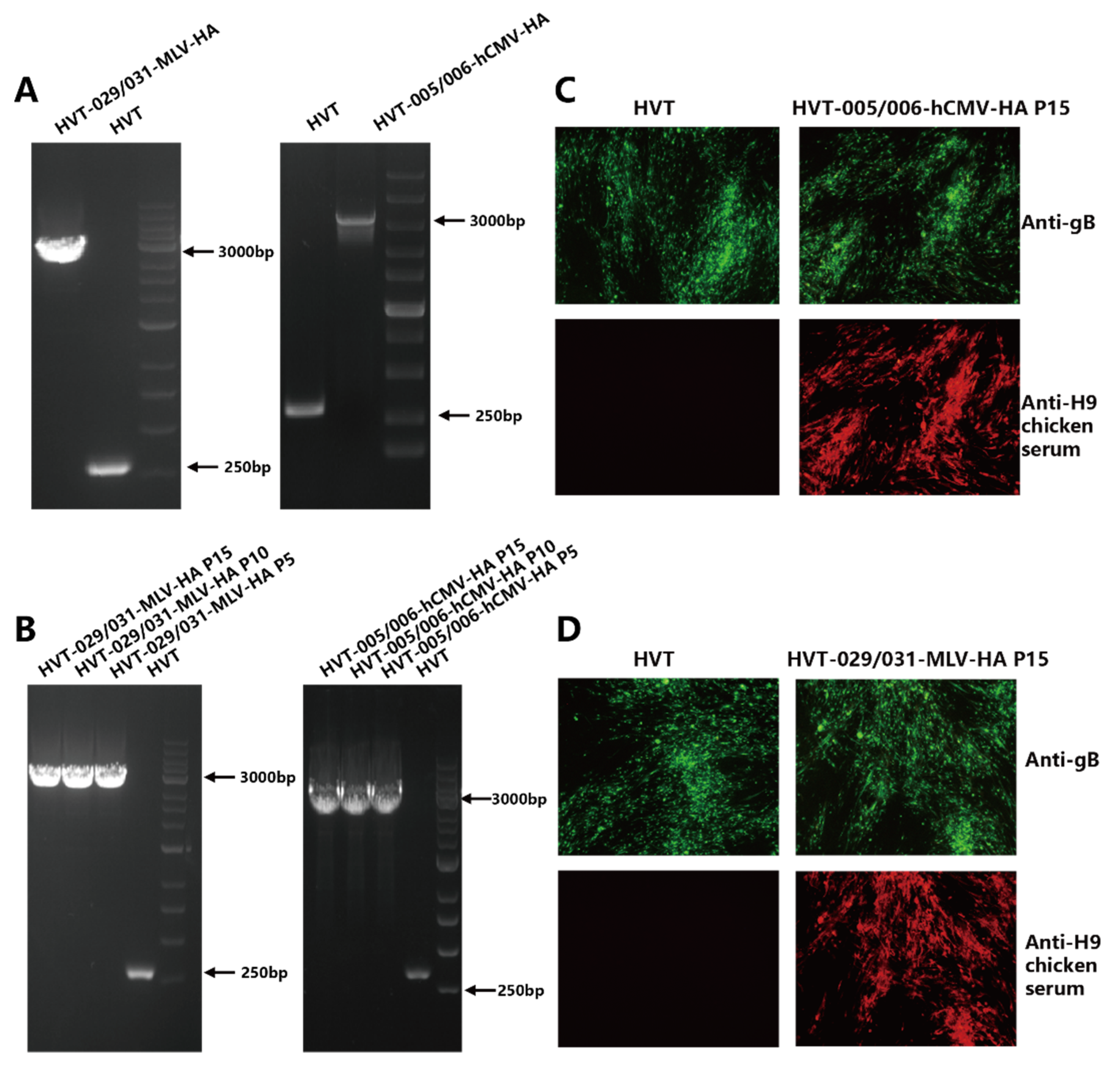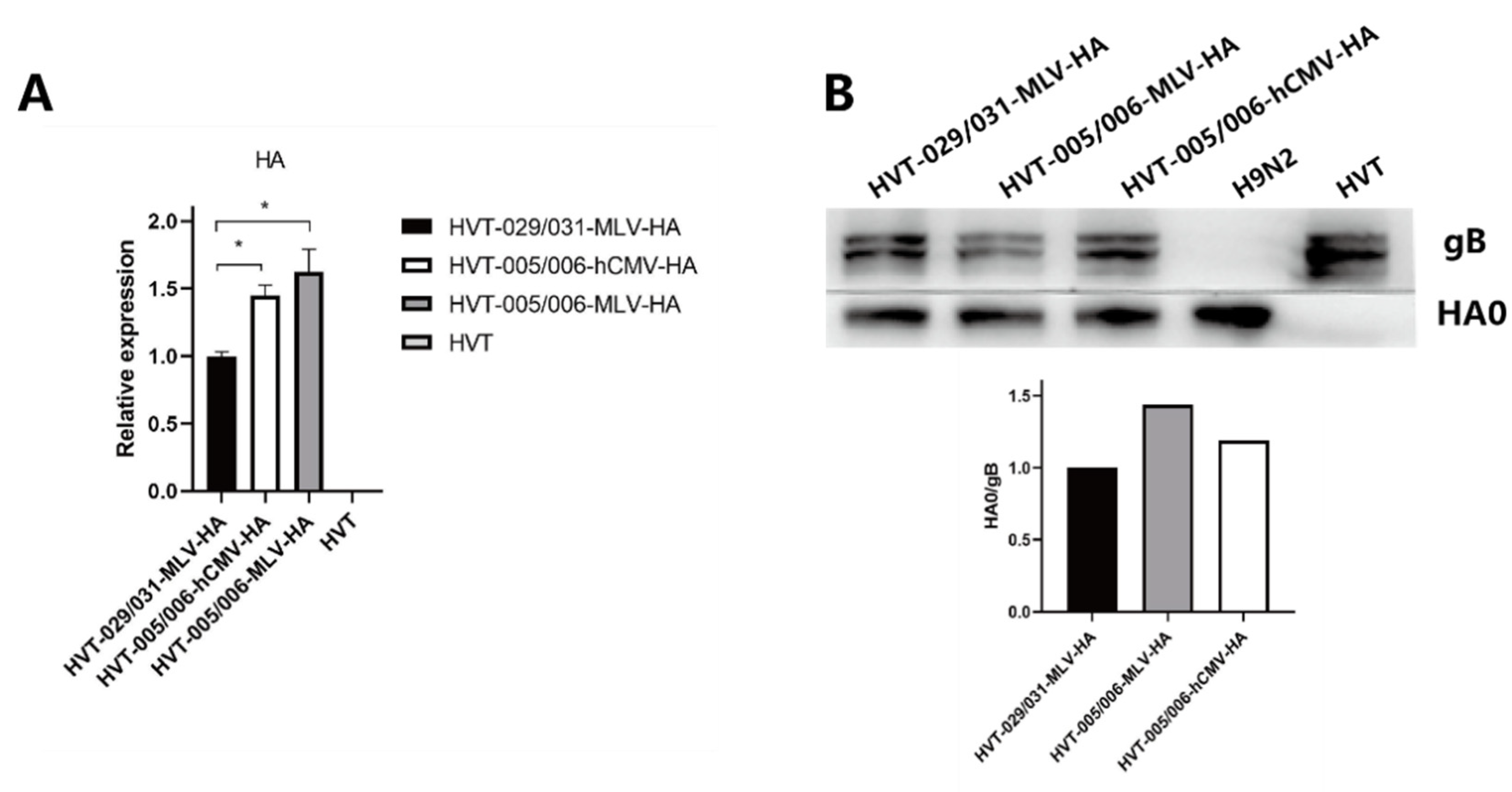Recombinant Turkey Herpesvirus Expressing H9N2 HA Gene at the HVT005/006 Site Induces Better Protection Than That at the HVT029/031 Site
Abstract
:1. Introduction
2. Materials and Methods
2.1. Viruses and Cell Culture
2.2. Generation of the Recombinant HVT-HA Viruses
2.3. Viral Growth Kinetics
2.4. HA Expression of the Recombinant HVT Viruses In Vitro
2.5. Immunization and Bird Challenge Experiments
2.6. Hemagglutination Inhibition Assay
2.7. Statistical Analyses
3. Results
3.1. Generation of the Recombinant HVT-HA Viruses
3.2. Growth Kinetics of Different Recombinant HVT-HA Viruses In Vitro
3.3. Comparison of HA Expression of Different Recombinant HVT-HA Viruses In Vitro
3.4. Protective Efficacy of Recombinant HVT-HA Viruses against AIV H9N2 in Chickens
3.5. Antibody Responses against H9N2 Virus Induced by Recombinant HVT-HA Viruses in Vaccinated Chickens
4. Discussion
Author Contributions
Funding
Institutional Review Board Statement
Informed Consent Statement
Data Availability Statement
Conflicts of Interest
References
- Vagnozzi, A.; Zavala, G.; Riblet, S.M.; Mundt, A.; García, M. Protection induced by commercially available live-attenuated and recombinant viral vector vaccines against infectious laryngotracheitis virus in broiler chickens. Avian Pathol. 2012, 41, 21–31. [Google Scholar] [CrossRef] [PubMed]
- Li, Y.; Reddy, K.; Reid, S.M.; Cox, W.J.; Brown, I.H.; Britton, P.; Nair, V.; Iqbal, M. Recombinant herpesvirus of turkeys as a vector-based vaccine against highly pathogenic H7N1 avian influenza and Marek’s disease. Vaccine 2011, 29, 8257–8266. [Google Scholar] [CrossRef] [PubMed]
- Tsukamoto, K.; Saito, S.; Saeki, S.; Sato, T.; Tanimura, N.; Isobe, T.; Mase, M.; Imada, T.; Yuasa, N.; Yamaguchi, S. Complete, long-lasting protection against lethal infectious bursal disease virus challenge by a single vaccination with an avian herpesvirus vector expressing VP2 antigens. J. Virol. 2002, 76, 5637–5645. [Google Scholar] [CrossRef] [PubMed] [Green Version]
- Reddy, S.K.; Sharma, J.M.; Ahmad, J.; Reddy, D.N.; McMillen, J.K.; Cook, S.M.; Wild, M.A.; Schwartz, R.D. Protective efficacy of a recombinant herpesvirus of turkeys as an in ovo vaccine against Newcastle and Marek’s diseases in specific-pathogen-free chickens. Vaccine 1996, 14, 469–477. [Google Scholar] [CrossRef]
- Calnek, B.W. Pathogenesis of Marek’s disease virus infection. Curr. Top. Microbiol. Immunol. 2001, 255, 25–55. [Google Scholar] [CrossRef]
- Richard-Mazet, A.; Goutebroze, S.; Le Gros, F.X.; Swayne, D.E.; Bublot, M. Immunogenicity and efficacy of fowlpox-vectored and inactivated avian influenza vaccines alone or in a prime-boost schedule in chickens with maternal antibodies. Vet. Res. 2014, 45, 107. [Google Scholar] [CrossRef]
- Bertran, K.; Lee, D.H.; Criado, M.F.; Balzli, C.L.; Killmaster, L.F.; Kapczynski, D.R.; Swayne, D.E. Maternal antibody inhibition of recombinant Newcastle disease virus vectored vaccine in a primary or booster avian influenza vaccination program of broiler chickens. Vaccine 2018, 36, 6361–6372. [Google Scholar] [CrossRef]
- Tarpey, I.; Davis, P.J.; Sondermeijer, P.; van Geffen, C.; Verstegen, I.; Schijns, V.E.; Kolodsick, J.; Sundick, R. Expression of chicken interleukin-2 by turkey herpesvirus increases the immune response against Marek’s disease virus but fails to increase protection against virulent challenge. Avian Pathol. 2007, 36, 69–74. [Google Scholar] [CrossRef]
- Gao, H.; Cui, H.; Cui, X.; Shi, X.; Zhao, Y.; Zhao, X.; Quan, Y.; Yan, S.; Zeng, W.; Wang, Y. Expression of HA of HPAI H5N1 virus at US2 gene insertion site of turkey herpesvirus induced better protection than that at US10 gene insertion site. PLoS ONE 2011, 6, e22549. [Google Scholar] [CrossRef]
- Gergen, L.; Cook, S.; Ledesma, B.; Cress, W.; Higuchi, D.; Counts, D.; Cruz-Coy, J.; Crouch, C.; Davis, P.; Tarpey, I.; et al. A double recombinant herpes virus of turkeys for the protection of chickens against Newcastle, infectious laryngotracheitis and Marek’s diseases. Avian Pathol. 2019, 48, 45–56. [Google Scholar] [CrossRef]
- Tang, N.; Zhang, Y.; Sadigh, Y.; Moffat, K.; Shen, Z.; Nair, V.; Yao, Y. Generation of A Triple Insert Live Avian Herpesvirus Vectored Vaccine Using CRISPR/Cas9-Based Gene Editing. Vaccines 2020, 8, 97. [Google Scholar] [CrossRef] [PubMed] [Green Version]
- Zai, X.; Shi, B.; Shao, H.; Qian, K.; Ye, J.; Yao, Y.; Nair, V.; Qin, A. Identification of a Novel Insertion Site HVT-005/006 for the Generation of Recombinant Turkey Herpesvirus Vector. Front. Microbiol. 2022, 13, 886873. [Google Scholar] [CrossRef] [PubMed]
- Andoh, K.; Yamazaki, K.; Honda, Y.; Honda, T. Turkey herpesvirus with an insertion in the UL3-4 region displays an appropriate balance between growth activity and antibody-eliciting capacity and is suitable for the establishment of a recombinant vaccine. Arch. Virol. 2017, 162, 931–941. [Google Scholar] [CrossRef]
- Peacock, T.H.P.; James, J.; Sealy, J.E.; Iqbal, M. A Global Perspective on H9N2 Avian Influenza Virus. Viruses 2019, 11, 620. [Google Scholar] [CrossRef] [Green Version]
- Bi, Y.; Li, J.; Li, S.; Fu, G.; Jin, T.; Zhang, C.; Yang, Y.; Ma, Z.; Tian, W.; Li, J.; et al. Dominant subtype switch in avian influenza viruses during 2016-2019 in China. Nat. Commun. 2020, 11, 5909. [Google Scholar] [CrossRef] [PubMed]
- Cui, B.; Liao, Q.; Lam, W.W.T.; Liu, Z.P.; Fielding, R. Avian influenza A/H7N9 risk perception, information trust and adoption of protective behaviours among poultry farmers in Jiangsu Province, China. BMC Public Health 2017, 17, 463. [Google Scholar] [CrossRef] [PubMed] [Green Version]
- Gao, G.F. Influenza and the live poultry trade. Science 2014, 344, 235. [Google Scholar] [CrossRef] [Green Version]
- Liu, D.; Shi, W.; Gao, G.F. Poultry carrying H9N2 act as incubators for novel human avian influenza viruses. Lancet 2014, 383, 869. [Google Scholar] [CrossRef]
- Wang, F.; Wu, J.; Wang, Y.; Wan, Z.; Shao, H.; Qian, K.; Ye, J.; Qin, A. Identification of key residues involved in the neuraminidase antigenic variation of H9N2 influenza virus. Emerg. Microbes Infect. 2021, 10, 210–219. [Google Scholar] [CrossRef]
- Baigent, S.J.; Smith, L.P.; Currie, R.J.W.; Nair, V.K. Replication kinetics of Marek’s disease vaccine virus in feathers and lymphoid tissues using PCR and virus isolation. J. Gen. Virol. 2005, 86, 2989–2998. [Google Scholar] [CrossRef]
- Baigent, S.J.; Petherbridge, L.J.; Smith, L.P.; Zhao, Y.; Chesters, P.M.; Nair, V.K. Herpesvirus of turkey reconstituted from bacterial artificial chromosome clones induces protection against Marek’s disease. J. Gen. Virol. 2006, 87, 769–776. [Google Scholar] [CrossRef] [PubMed]
- Hu, X.; Qin, A.; Qian, K.; Shao, H.; Yu, C.; Xu, W.; Miao, J. Analysis of protein expression profiles in the thymus of chickens infected with Marek’s disease virus. Virol. J. 2012, 9, 256. [Google Scholar] [CrossRef] [PubMed] [Green Version]
- Pedersen, J.C. Hemagglutination-inhibition test for avian influenza virus subtype identification and the detection and quantitation of serum antibodies to the avian influenza virus. Methods Mol. Biol. (Clifton N. J.) 2008, 436, 53–66. [Google Scholar] [CrossRef]
- Li, K.; Liu, Y.; Liu, C.; Gao, L.; Zhang, Y.; Gao, Y.; Cui, H.; Qi, X.; Zhong, L.; Wang, X. Effects of different promoters on the protective efficacy of recombinant Marek’s disease virus type 1 expressing the VP2 gene of infectious bursal disease virus. Vaccine 2016, 34, 5744–5750. [Google Scholar] [CrossRef]
- Swayne, D.E.; Suarez, D.L.; Spackman, E.; Jadhao, S.; Dauphin, G.; Kim-Torchetti, M.; McGrane, J.; Weaver, J.; Daniels, P.; Wong, F.; et al. Antibody titer has positive predictive value for vaccine protection against challenge with natural antigenic-drift variants of H5N1 high-pathogenicity avian influenza viruses from Indonesia. J. Virol. 2015, 89, 3746–3762. [Google Scholar] [CrossRef] [Green Version]
- Sun, Y.; Yang, C.; Li, J.; Li, L.; Cao, M.; Li, Q.; Li, H. Construction of a recombinant duck enteritis virus vaccine expressing hemagglutinin of H9N2 avian influenza virus and evaluation of its efficacy in ducks. Arch. Virol. 2017, 162, 171–179. [Google Scholar] [CrossRef]
- Liu, L.; Wang, T.; Wang, M.; Tong, Q.; Sun, Y.; Pu, J.; Sun, H.; Liu, J. Recombinant turkey herpesvirus expressing H9 hemagglutinin providing protection against H9N2 avian influenza. Virology 2019, 529, 7–15. [Google Scholar] [CrossRef]
- Kapczynski, D.R.; Esaki, M.; Dorsey, K.M.; Jiang, H.; Jackwood, M.; Moraes, M.; Gardin, Y. Vaccine protection of chickens against antigenically diverse H5 highly pathogenic avian influenza isolates with a live HVT vector vaccine expressing the influenza hemagglutinin gene derived from a clade 2.2 avian influenza virus. Vaccine 2015, 33, 1197–1205. [Google Scholar] [CrossRef] [Green Version]
- Nassif, S.; Zaki, F.; Mourad, A.; Fouad, E.; Saad, A.; Setta, A.; Felföldi, B.; Mató, T.; Kiss, I.; Palya, V. Herpesvirus of turkey-vectored avian influenza vaccine offers cross-protection against antigenically drifted H5Nx highly pathogenic avian influenza virus strains. Avian Pathol. 2020, 49, 547–556. [Google Scholar] [CrossRef]



| Group* | Vaccination (1-Day-Old Chickens) | Vaccine Dose (PFU) | Challenge Infection (28-Day-Old Chickens) | Challenge Dose (EID50) |
|---|---|---|---|---|
| 1 | HVT-005/006-MLV-HA | 5000 | A/Chicken/China/H1/2019(H9N2) | 108 |
| 2 | HVT-005/006-hCMV-HA | 5000 | A/Chicken/China/H1/2019(H9N2) | 108 |
| 3 | HVT-029/031-MLV-HA | 5000 | A/Chicken/China/H1/2019(H9N2) | 108 |
| 4 | HVT | 5000 | A/Chicken/China/H1/2019(H9N2) | 108 |
| 5 | HVT | 5000 | / | / |
| Vaccination | Virus Isolation from Swabs (Shedding/Total) | |
|---|---|---|
| 3 (Days Post Challenge, dpc) | 5 (dpc) | |
| HVT-005/006-MLV-HA * | 2/10 | 0/10 |
| HVT-005/006-hCMV-HA * | 1/10 | 0/10 |
| HVT-029/031-MLV-HA * | 3/10 | 2/10 |
| HVT * | 10/10 | 9/10 |
| HVT | 0/10 | 0/10 |
| Log2 HI Titer (Mean ± SD) | Days Post Vaccination (dpv) | |||
|---|---|---|---|---|
| 7 | 14 | 21 | 28 | |
| HVT-005/006-MLV-HA | 0 | 0.6 ± 0.55 | 2.8 ± 0.84 | 4.8 ± 0.84 |
| HVT-005/006-hCMV-HA | 0 | 0.8 ± 0.45 | 2.4 ± 0.55 | 4.4 ± 0.55 |
| HVT-029/031-MLV-HA | 0 | 0.6 ± 0.55 | 2.0 ± 0.71 | 4.2 ± 1.1 |
| HVT | 0 | 0 | 0 | 0 |
Publisher’s Note: MDPI stays neutral with regard to jurisdictional claims in published maps and institutional affiliations. |
© 2022 by the authors. Licensee MDPI, Basel, Switzerland. This article is an open access article distributed under the terms and conditions of the Creative Commons Attribution (CC BY) license (https://creativecommons.org/licenses/by/4.0/).
Share and Cite
Zai, X.; Shi, B.; Shao, H.; Qian, K.; Ye, J.; Yao, Y.; Nair, V.; Qin, A. Recombinant Turkey Herpesvirus Expressing H9N2 HA Gene at the HVT005/006 Site Induces Better Protection Than That at the HVT029/031 Site. Viruses 2022, 14, 2495. https://doi.org/10.3390/v14112495
Zai X, Shi B, Shao H, Qian K, Ye J, Yao Y, Nair V, Qin A. Recombinant Turkey Herpesvirus Expressing H9N2 HA Gene at the HVT005/006 Site Induces Better Protection Than That at the HVT029/031 Site. Viruses. 2022; 14(11):2495. https://doi.org/10.3390/v14112495
Chicago/Turabian StyleZai, Xusheng, Bin Shi, Hongxia Shao, Kun Qian, Jianqiang Ye, Yongxiu Yao, Venugopal Nair, and Aijian Qin. 2022. "Recombinant Turkey Herpesvirus Expressing H9N2 HA Gene at the HVT005/006 Site Induces Better Protection Than That at the HVT029/031 Site" Viruses 14, no. 11: 2495. https://doi.org/10.3390/v14112495







